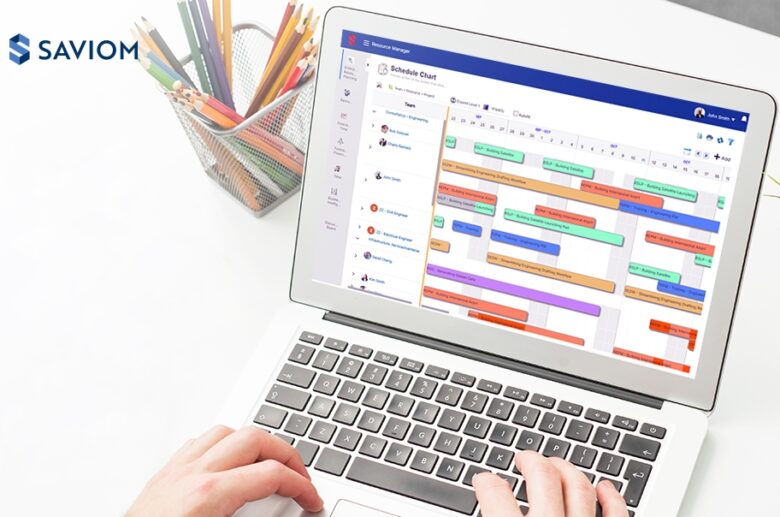Consider the following scenario, a construction project is in the pipeline stage, and the manager assigned resources using a spreadsheet. However, they ended up scheduling resources that had already been allotted to a different project. This double-booking chaos further led to project delays, compromised deliverables, employee overutilization, and client dissatisfaction.
This example highlights the importance of understanding employee availability, experience, qualifications, and capabilities in advance for efficient resource scheduling in a dynamic and complex project environment.
By utilizing advanced resource management solutions, you can ensure that the right resource is assigned to the right project. As a result, it helps reduce resourcing costs, improve employee retention, streamline operations, increase client satisfaction, and enhance business profitability.
This article discusses the limitations of traditional scheduling tools and how Saviom’s advanced resource management tool can help resolve these challenges.
So, let’s begin.
Contents
 1. Resource Scheduling: Definition and its importance
1. Resource Scheduling: Definition and its importance
Resource scheduling entails identifying and assigning resources to various project and non-project-related activities for a specific period.
Effective resource scheduling allows project managers to assign work to their workforce based on their knowledge and availability. It also helps deploy the right resources to project tasks, ensuring high employee productivity and enhanced work quality.
By adopting a proper resource scheduling process, organizations can ensure that their staff is not underutilized or overburdened with work and that all deliverables are met within time and budget. In addition, when resources are optimally utilized, it reduces the instances of stress, burnout, low morale, disengagement, etc. Furthermore, it helps deliver the projects on time within budget enhancing client satisfaction while guaranteeing organizational productivity.
Now that we’ve established the importance of resource scheduling let’s look at the shortcomings of conventional resource scheduling solutions.
 2. Limitations of the traditional Resource Scheduling Solutions
2. Limitations of the traditional Resource Scheduling Solutions
The following are some drawbacks of legacy and homegrown tools:
2.1 Lack of enterprise-wide visibility
Many organizations have resources spanning across geographical boundaries. Therefore, they need 360-degree visibility for multidimensional resource scheduling. However, when organizations leverage spreadsheets or legacy tools, they cannot get complete visibility of all resource metrics in an enterprise. Moreover, manually updating and reconciling spreadsheets is error-prone and cannot be modified in real-time.
As a result, resource-related information cannot be centralized on a single platform. As a result, the organization faces challenges such as double booking, last-minute hiring, increased overhead costs, etc.
2.2 Unable to forward plan pipeline resource requirement
Resource forecasting is crucial to plan future project demand as it helps managers bridge the capacity vs demand gap ahead of the curve. Legacy tools or spreadsheets, however, lack forecasting capabilities and organizations rely on approximations and guesstimates.
As a result, managers find it challenging to plan their pipeline projects and do not get sufficient lead time to fulfill resource demands. In addition, it leads to last-minute firefighting, increased hiring/ firing cycles, etc.

Source: pinterest.com
2.3 Inability to filter and identify competent resources
When organizations rely on homegrown and legacy tools, they cannot determine if there is a shortage or excess of resources for future projects. Further, they also fail to filter or identify the right resource for projects.
For instance, managers may assign over or under-qualified resources to tasks that can cause budget or schedule overruns. This can also result in the delivery of substandard projects, client dissatisfaction, etc.
2.4 Difficult to capture employees’ vacation & leaves
The siloed data from disparate spreadsheets make it difficult for decision-makers to maintain a single source of truth. Therefore, organizations fail to track or efficiently capture employees’ vacations and leaves or create a backup plan in advance.
When an employee takes an unplanned leave, and there is no suitable replacement for that person, the organization will struggle to meet the project deadlines. Consequently, it leads to project halts, poor brand reputation, and low client retention. It will also negatively impact the overall health of the organization.

Source: forbes.com
2.5 Inadequate business intelligence capabilities
The legacy and homegrown tools lack business intelligence capabilities. For example, they aren’t equipped to generate real-time analytics and customized reports on numerous resource parameters.
As a result, managers fail to make data-driven and informed decisions. For instance, managers cannot procure reports of different metrics such as utilization and availability to prevent over or under-utilization of the workforce. This can negatively impact workforce productivity and lead to uneven work distribution. All of this severely affects business profitability and sustainability.
Now let’s see how a resource management tool can assist in streamlining scheduling.
3. How advanced resource management software can streamline scheduling?
Resource management software enables organizations to assign the right resources to meet the resource demands.
- Using the tool, organizations can achieve enterprise-wide visibility into all work demand types and resources. Accordingly, managers can match their skills, availability, preference, cost rate, and experience following the job requirement.
- Apart from this, the Gantt chart scheduler helps track a project’s progress and depending on the individual’s availability, dynamic bookings can be made with a simple drag-and-drop option.
- The tool forecasts capacity vs demand from multiple dimensions, i.e., by role, department, team, location, skills, etc. Through its unique capabilities, one can identify short or long-term shortages/excess resources ahead of time and reduce undesirable hiring/firing decisions.
- The software also facilitates optimal utilization of resources to ensure uniformity of workload. This not only increases productivity manifold times but also saves time.
- The tool also enables effective bench management and predicts the resources likely to end up on the bench. This allows managers to allocate the following project tasks to the employees well in advance, which will aid in reducing bench time. Further, one can find the best-fit resource through internal channels saving hiring costs.

Source: projectcubicle.com
Conclusion
To overcome pertinent resource-related challenges, businesses must replace legacy tools with futuristic resource management software. It is time for companies to look for a solution beyond simply allocation. By switching to an advanced resource management tool, you can identify tasks, locate relevant resources, and complete projects on time and within budget, thereby taking your business to the next level.
What scheduling strategies does your organization employ?
